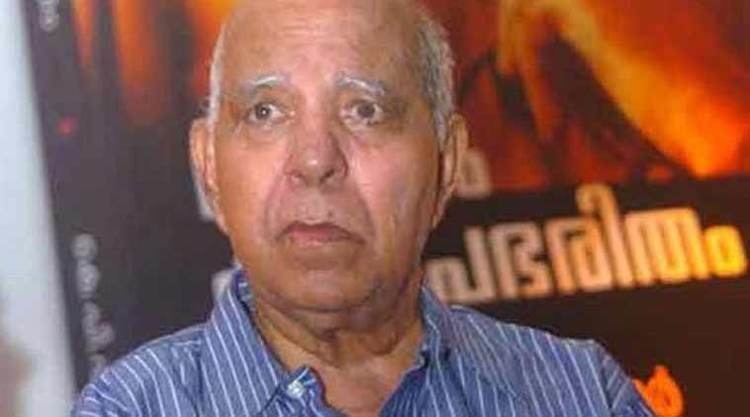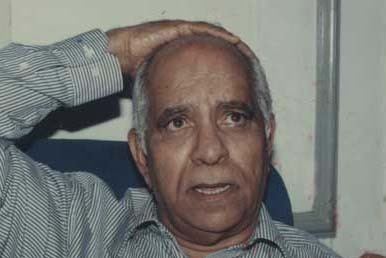Name K. P. Role Industrialist | ||
 | ||
Died 30 June 2015Bangalore, India Occupation Industrialist, technocrat Spouse(s) Marjorie Agnes NambiarSaroja KamakshiUma Devi Nambiar Children Sarojini L. NambiarPadman G. NambiarKiran P. Nambiar Parent(s) P. P. Chindan NambiarK. P. Madhavi Amma | ||
Technocrat K P P Nambiar no more,കെ പി പി നമ്പ്യാര് അന്തരിച്ചു
Kunnath Puthiyaveettil Padmanabhan Nambiar MSc (Lond), DIC (Lond), FIEE (Lond), CEngg (Lond.), more popularly known as K.P.P. Nambiar (April 15, 1929 - June 30, 2015), was an Indian industrialist and technocrat, known for his work in the field of industrial development and technology. He was awarded Padma Bhushan by Government of India for his contributions to the field of technology in 2006.
Contents

Career

Nambiar walked 8 km everyday to Taliparamba's Moothedeth High School. He graduated from Pachayyappa's College in Madras where he studied Physics. In 1951, he joined the Imperial College of Science & Technology, University of London for higher studies in Transistors and Semi-Conductors.

Nambiar started his career as a research scholar in semi-conductor technology at Imperial College from 1954 to 1957. After graduation, he worked for Texas Instruments, USA. In 1963 he returned to India, as a part of the Scientist pool scheme initiated by Late Prime Minister Jawaharlal Nehru to bring back talented Indians working abroad. He was a "Scientist Pool Officer" under the Council of Scientific and Industrial Research (CSIR). He taught modern semiconductor electronics in the Electrical Engineering Department of the Indian Institute of Technology, New Delhi. Nambiar joined Philips India as Manager of Projects in 1964. In 1967, he joined Bharat Electronics Limited as Joint Head of the Piezo Electric Crystal Division in Bangalore, where he set up the first communication crystals factory in India during his brief stay there.
In 1967, while at Tata Electric Companies, he set up the first applied Electronic Research and Development Centre for industrial electronics in India. In late 1967, Nambiar was also the general manager of National Radio & Electronics Co. Ltd., (NELCO), the consumer electronics division on Tatas. He was instrumental in introducing a number of new products under NELCO banner such as speed control for AC and DC Motors, Static Inverters and Converters, Calculators, Electronic Clocks and Display Systems. Silicon transistor radios were introduced for the first time in the country in 1968 by NELCO during this period. In the early 70s, he received an invitation from Kerala Government to set up an electronics manufacturing firm in Kerala. Kerala State Electronics Development Corporation Limited (KELTRON) was formed with K. P. P. Nambiar as its first chairman and managing director. He remained in that position till 1983 when he was made the Executive chairman till his retirement in 1985. In 1985, Indira Gandhi appointed Nambiar as the chairman and managing director of Indian Telephone Industries Limited, the largest Public Sector Company in Telecommunication. In 1986, K.P.P. Nambiar was appointed the Secretary, Department of Electronics of Government of India (now the Ministry of IT) by Prime Minister Rajiv Gandhi. He retired from Government service in 1989. The Kerala Government, in 1989, appointed him as the Honorary Special Advisor. In this consultancy role, he drew up the blue print for Techno Park in Thiruvananthapuram. The Park was inaugurated on 31 March 1991.
When acting as the Special Advisor, Nambiar set up a private company in Bangalore, Namtech Electronic Devices Limited, for the manufacture of Fail Safe Gas Discharge Tubes used as Surge Arresters in Electronic and Telecommunication equipment. Namtech is also involved in the manufacture of quartz crystals, crystal oscillators, light emitting diodes (LEDs) and LED Displays. In February 1995, Nambiar launched an INR 15 billion project to generate 513 MW of Power under the name of Kannur Power Projects (P) Limited in his native Panchayat of Kalliasseri in Kannur District in North Kerala. However, the project ran into political and supply issues and had to be abandoned. He was also instrumental in the launching of a joint venture company Bowthorpe Thermometrics India (P) Limited, with Bowthorpe of UK and Namtech Consultants (P) Limited to manufacture Thermisters (a temperature dependent Resistor) in 1996. Bowthorpe has since transferred its ownership to GE in October 2001.
Nambiar suffered a stroke in 2002 and he died on 30 June 2015 at the age of 86 in Bengaluru.
Personal life
Kunnath Puthiyaveettil Padmanabhan Nambiar was born in a middle-class Nambiar Kshatriya family in Kalliassery, Kannur in North Kerala to P. P. Chindan Nambiar and K. P. Madhavi Amma. He has four brothers, Narayanan Kutty, Prabhakaran, Unnikrishnan and Ramachandran and five sisters, Kamalakshi, Gowri, Girija, Sarojini and Janaki. From his marriage to Marjorie Agnes Nambiar in London (1953) he has two children - a daughter, Sarojini and a son, Padman. He has five grand children - Mrinalini, Arjun, Aneil, Daniel and Kimberly - and one great grandson. While living in Bombay, he met and married Saroja Kamakshi, mother of celebrated Indian classical dancer, Malavika Sarukkai. In the 1980s, Nambiar married again, to Uma Devi of Calicut. They have one son, Kiran.
Legacy
As the Secretary, Department of Electronics of Government of India 1986–89, Nambiar was successful initiating and implementing several new policy initiatives in Research and Development, specifically manufacturing and application of electronics throughout the country. He played a major role in developing the Indian Electronics Industry including the establishment of C-DAC, STPI, CEDTI and VLSI laboratories. In the 1980s, the import of hardware or software systems was nearly impossible due to heavy taxation. Understanding that such products would help build a better India, Nambiar was instrumental in orchestrating the necessary government approvals.
During his stint (1989 to 1991) as the Special Advisor to the Government of Kerala on Industries, Nambiar set up India's first Electronic Technology Park (Techno Park) in Trivandrum to provide infrastractural support required to set up high technology electronic units in the State. He also set up a chain of Electronic Industries in different parts of Kerala from Trivandrum to Kannur in the major areas of electronic components, industrial electronics, consumer electronics and telecommunication between 1973 and 1984.
He was responsible for expanding Palakkad unit of Indian Telephone Industries Limited from a INR 40 million unit to an INR 2 billion enterprise. Nambiar is credited with evolving a new concept of consortium of ancillary industries by mobilising all the 41 ancillary industries of Indian Telephone Industries in Bangalore to form a consortium company to manufacture plan 103 telephone instruments with a turnover of more than INR 200 million.
As the Founder Chairman of Keltron, Nambiar was instrumental in taking electronics to the villages by setting up 50 women's co-operatives that produced most of the consumer products sold by Keltron. He introduced for the first time in India the concept of village women’s co-operative for manufacture of electronic assembly oriented products thereby taking industries to the villages of Kerala. Keltron’s manufacturing units were also situated all over the state in rural areas, directly and indirectly employing several thousand people. The concept of women’s co-operatives in villages was emulated by various State Governments like Punjab, Bihar, Manipur, Pondicheery and Uttar Pradesh. Keltron also trained a number of unskilled workers into skilled electronic equipment assembly operators enabling them to work in women's co-operatives in Ranchi, Pondicherry and Imphal and Lakshadeep.
He also developed the R&D Center for Keltron, the Electronics Research & Development Center, which was later taken over by the Department of Electronics and has now been brought under C-DAC. KELTRON, was the first autonomous Corporation in the State sector in India, an example later emulated by several state Governments in the country.
During his stint as the Honorary Special Advisor to Government of Kerala on Industries, Nambiar influenced Ratan Tata, the Chairman of Tata Industries, to invest in Kerala, resulting in the formation of Taj Hotels and Resorts, Kerala and Tata Ceramics (Kerala) Limited.
He received a Padma Bhushan in 2006 for all of his contributions to the field of Science and Engineering in India.
